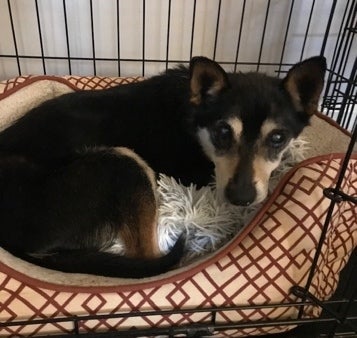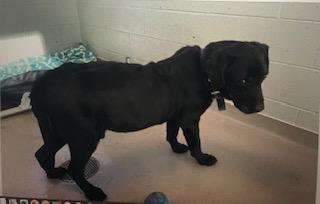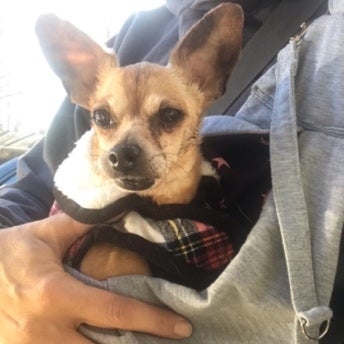
I waited in the lobby of the shelter for my name to be called. It was Jan. 3, and I was there to pick up our first foster dog of the year. He had been found as a stray and was brought to the shelter. He was described as a sweet old man who was hungry, skinny and unsteady. He had cataracts and tested positive for heartworms. He was not neutered.
“Is there someone here from Hope Animal Rescue?” the shelter employee called out. “Thank you for coming. He will feel much better once he gets a bath and is in a quieter setting,” she told me as I followed her down the hall. “He’s a bit overwhelmed.”
When we reached his kennel he was pacing, and one side of his body was covered with feces. He was extremely skinny and his ribs protruded from his body. The shelter employee reached in and grabbed him, wrapping him in a towel.
“Thank you again for saving him,” she said as she handed him to me. His body trembled and I held him close as we walked out. “Let’s go home.”
My husband and I started fostering senior dogs in 2015, and this dog would be foster number 65 for us. Over the years, we have seen the miraculous transformations that can happen when dogs in foster care receive the medical attention and care they need. To be a part of each dog’s journey is a blessing, and the sense of accomplishment we feel once the dogs go on to their forever home is like none other.
We decided to call this foster “Jango,” which is a South African word that means brave and amazing. Like most new fosters, he was confused and disoriented the first few days. He paced and had difficulty settling down. But over the days that followed, we started noticing some unusual behaviors ― he pressed his nose into the corner of his crate to let himself down and he didn’t seem to know how to drink water from a bowl. He didn’t have interest in people or other dogs.

At his vet appointment, we learned he had a grade 4/5 heart murmur and advanced dog dementia, which explained his odd habits. He was not all there and did not know what was going on. “He’s a hospice dog,” the doctor explained. “We don’t have to do anything today. Take him home and keep him comfortable for a few days.”
I took Jango home, monitored him and deliberated with the rescue. We made the appointment for his euthanasia on Monday. The next morning, we found Jango sleeping on the kitchen floor in his urine and feces. He had escaped from his crate and went into the kitchen where he had fallen and could not get up.
There are things dogs do when they are in a certain stage of dying; they get frantic, as if they want to leave their own body. They cannot settle down. Jango was not our first hospice dog; I had seen this behavior before. I realized it was his time, and we could not wait until Monday. I called another vet that was open on the weekend. We said goodbye to Jango that afternoon.
Each foster dog teaches me something different; and each lesson helps me become a better advocate for the next dog. In Jango’s case, my job as his foster was not to find him a home, but rather, to help free him from suffering. I realized I had the emotional space and capacity to do that for him, and with Jango being the first foster of the year, this realization felt significant. I made a promise to be there for other dogs like him. The universe took me up on that.

Can anyone spoil this boy for whatever time he has left? This is Priest, a 15-year-old black Lab who was chained in the backyard his whole life. He is neutered and heartworm positive. He is in rough shape but despite that he is affectionate. Is there an angel that can save him?
This plea was posted on social media by another local rescue organization just days after we said goodbye to Jango. The picture taken at the shelter showed a sad-looking black Lab. looked at Priest’s face and imagined his condition. He needed help, and I knew I could do it. I sent a message to the rescue and heard back immediately. I picked Priest up from the shelter that day.
Once home, Priest did not want to eat and he struggled to get comfortable. He had no interest in exploring the house or meeting the other dogs ― he was too tired for that. I put a comforter on the floor and as we sat together, I stroked his back. His body was lumpy and bloated and he smelled as if he had never been bathed. Priest shifted to get comfortable and put his head on my lap. I felt his muscles relax and eventually he fell asleep.
As Priest slept, I thought about what his life must have been like, tied to a tree. The condition of his body told a story of neglect. To his owners, he was nothing more than a possession that they later disposed of when he was at the end of his life. They are not alone. We have an epidemic of abandoned senior pets in our country. Some are left on the side of the road, others surrendered to shelters. There are cases where owners can no longer take care of their pets, and they are left with no other choice but to surrender them, but that is not always the case.
In animal rescue, we focus on being part of the solution rather than dwelling on the problem. But with the number of homeless senior pets, we must ask the question ― what would lead so many people to abandon their pets at the end of their lives? Has capitalism affected us such that we only see animals only as commodities? The breeding industry is a result of that. Or is it our inability to face death; with the mortality of a pet being a stark reminder of our own mortality? Regardless of the reason, in the end, it is the animals who suffer.
That is where animal rescue comes in. In Priest’s case, I could not make up for the mistreatment he endured throughout his life, but I could be by his side to try to keep him comfortable, even if it was for one night.
Priest did not sleep for long that night. He panted and could not get comfortable. I counted down the hours until morning and tried to keep him comfortable in the meantime.
At his vet visit, X-rays showed his lungs were filled with cancer. Unlike Jango, Priest was all there mentally, but his body was failing him. We said goodbye to Priest that morning.
Spiritual guru Ram Dass says we are all here to walk each other home. After being with Jango and Priest during their final hours, I understood what that meant. I no longer feared death, I realized it is a natural transition, one that I was comfortable witnessing.
Being close to death also taught me how to grieve and celebrate life. I made altars with pictures of Jango and Priest, and lit candles in honor of their lives. I spread their ashes in our garden and wished them well on their journeys. I was grateful for the lessons both dogs taught me and knew they would serve to help other dogs in need. That next dog would be Coco.
Coco was a blind, five-pound, 16-year-old chihuahua who was surrendered to the shelter by her owner to be euthanized. Her person had health issues and could no longer care for Coco. My contact at the shelter sent me a text message with Coco’s picture. I picked Coco up from the shelter a few hours later.

In the beginning, Coco was confused, but she loved to be held and welcomed affection. She wagged her tail and had pep — she still had life left in her. At her wellness check, Coco trotted around the same exam room I had been in with Jango and Priest just weeks before.
Dr. B watched her. “She’s more with it than Jango was.” She examined Coco’s mouth and found a tumor. Coco also had a heart condition and was diabetic, which had caused her vision loss. “She probably doesn’t have more than a few months to live,” Dr. B told me, “But at least we can give her some quality of life.”
I learned to give Coco insulin shots and, over the next few months, her condition improved. Coco learned her way around the house and fell into our routine with the other dogs. Throughout the year, we fostered and found homes for nine other dogs, but Coco remained. Hospice care took on new meaning and we witnessed how far spirit and will to live can go. Not a day with Coco went by that I did not marvel at the miracle of life. Even now that she is no longer with us, my gratitude remains.
We said goodbye to Coco just last week, after 11 months and just shy of the new year. As I write this, Coco’s candle flickers in the background next to her pictures and our new foster, Sissy, sits by my side.
The plea to help Sissy came just 2 days after Coco’s death. At 10 years old, Sissy showed signs of diabetes and was partially blind as a result. Her person could not afford her medical care and made an appointment for her to be euthanized at the shelter.
That morning, I had looked at Coco’s bottle of insulin in the refrigerator, but couldn’t bring myself to dispose of it. When we got the call about Sissy that day and I found out we had the opportunity to help another diabetic dog, it all made sense. It always did.
That might be the most important lesson animal rescue has taught me ― to believe in the universe, and that nothing is coincidence. Our new foster dog is proof of that.
Not everyone can foster, but there is something we can all do for dogs in need. Adopt, foster, volunteer, donate or advocate. Please consider supporting your local shelter or animal rescue in 2023 however you can. No act of kindness is too small to help an animal in need.
Sarah Pai is a writer based in Durham, North Carolina. She’s also a foster and advocate for senior dogs with Hope Animal Rescue, and is working on a children’s book about animal rescue. Her website is sarahpai.com.
Do you have a compelling personal story you’d like to see published on HuffPost? Find out what we’re looking for here and send us a pitch.
